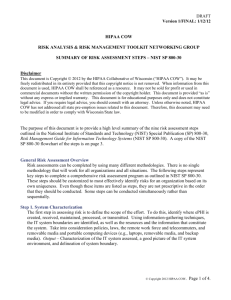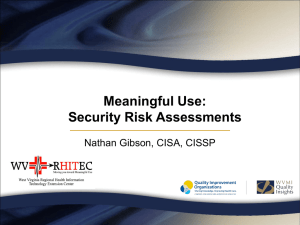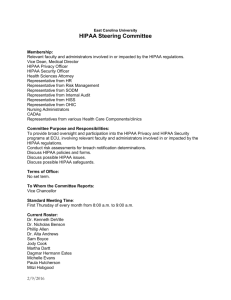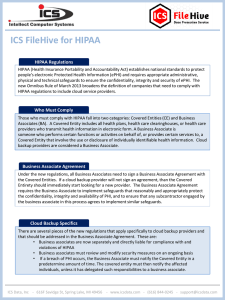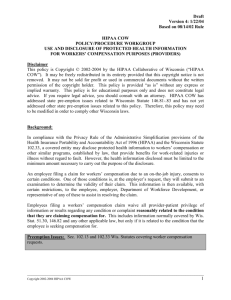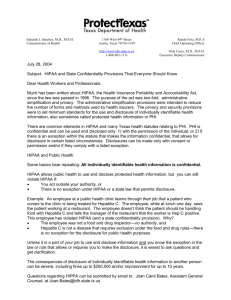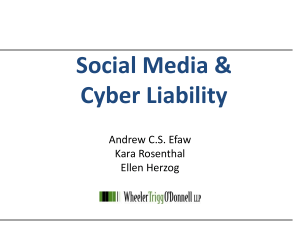Risk Management Policy
advertisement
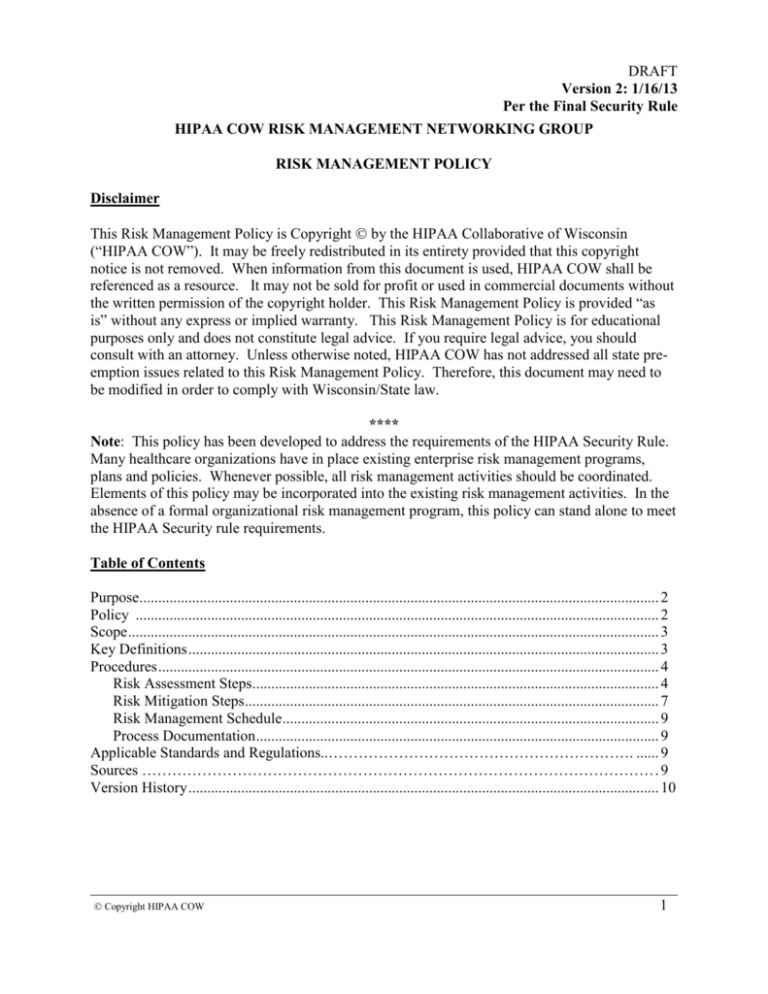
DRAFT Version 2: 1/16/13 Per the Final Security Rule HIPAA COW RISK MANAGEMENT NETWORKING GROUP RISK MANAGEMENT POLICY Disclaimer This Risk Management Policy is Copyright by the HIPAA Collaborative of Wisconsin (“HIPAA COW”). It may be freely redistributed in its entirety provided that this copyright notice is not removed. When information from this document is used, HIPAA COW shall be referenced as a resource. It may not be sold for profit or used in commercial documents without the written permission of the copyright holder. This Risk Management Policy is provided “as is” without any express or implied warranty. This Risk Management Policy is for educational purposes only and does not constitute legal advice. If you require legal advice, you should consult with an attorney. Unless otherwise noted, HIPAA COW has not addressed all state preemption issues related to this Risk Management Policy. Therefore, this document may need to be modified in order to comply with Wisconsin/State law. **** Note: This policy has been developed to address the requirements of the HIPAA Security Rule. Many healthcare organizations have in place existing enterprise risk management programs, plans and policies. Whenever possible, all risk management activities should be coordinated. Elements of this policy may be incorporated into the existing risk management activities. In the absence of a formal organizational risk management program, this policy can stand alone to meet the HIPAA Security rule requirements. Table of Contents Purpose.......................................................................................................................................... 2 Policy ........................................................................................................................................... 2 Scope ............................................................................................................................................. 3 Key Definitions ............................................................................................................................. 3 Procedures ..................................................................................................................................... 4 Risk Assessment Steps............................................................................................................ 4 Risk Mitigation Steps.............................................................................................................. 7 Risk Management Schedule .................................................................................................... 9 Process Documentation ........................................................................................................... 9 Applicable Standards and Regulations..……………………………………………………. ...... 9 Sources ………………………………………………………………………………………… . 9 Version History ............................................................................................................................. 10 ______________________________________________________________________________ Copyright HIPAA COW 1 DRAFT Version 2: 1/16/13 Per the Final Security Rule Purpose: This policy establishes the scope, objectives, and procedures of <ORGANIZATION’s> information security risk management process. The risk management process is intended to support and protect the organization and its ability to fulfill its mission. Policy: 1. It is the policy of <ORGANIZATION> to conduct thorough and timely risk assessments of the potential threats and vulnerabilities to the confidentiality, integrity, and availability of its electronic protected health information (ePHI) (and other confidential and proprietary electronic information) and to develop strategies to efficiently and effectively mitigate the risks identified in the assessment process as an integral part of the organization’s information security program. 2. Risk analysis and risk management are recognized as important components of <ORGANIZATION’s> corporate compliance program and Information Technology (IT) security program in accordance with the Risk Analysis and Risk Management implementation specifications within the Security Management standard and the evaluation standards set forth in the HIPAA Security Rule, 45 CFR 164.308(a)(1)(ii)(A), 164.308(a)(1)(ii)(B), 164.308(a)(1)(i), and 164.308(a)(8). A. Risk assessments are done throughout IT system life cycles: i. Before the purchase or integration of new technologies and changes are made to physical safeguards; ii. While integrating technology and making physical security changes; and iii. While sustaining and monitoring of appropriate security controls. B. The <ORGANIZATION> performs periodic technical and non-technical assessments of the security rule requirements as well as in response to environmental or operational changes affecting the security of ePHI. 3. <ORGANIZATION> implements security measures sufficient to reduce risks and vulnerabilities to a reasonable and appropriate level to: A. Ensure the confidentiality, integrity, and availability of all ePHI the organization creates, receives, maintains, and/or transmits, B. Protect against any reasonably anticipated threats or hazards to the security or integrity of ePHI, C. Protect against any reasonably anticipated uses or disclosures of ePHI that are not permitted or required, and D. Ensure compliance by workforce. 4. Any risk remaining (residual) after other risk controls have been applied, requires sign off by the <senior management, the organization’s Risk Management Team, and business managers>. 5. All <ORGANIZATION> workforce members are expected to fully cooperate with all persons charged with doing risk management work. Any workforce member that violates this policy will be subject to disciplinary action based on the severity of the violation according to <ORGANIZATION’s> Sanction policy. ______________________________________________________________________________ Copyright HIPAA COW 2 DRAFT Version 2: 1/16/13 Per the Final Security Rule 6. All risk management efforts, including decisions made on what controls to put in place as well as those to not put into place, are documented and the documentation is maintained for six years. Scope The scope of the information security risk management process covers the administrative, physical, and technical processes that enable and govern ePHI that is received, created, maintained or transmitted. Key Definitions: Electronic Protected Health Information (ePHI): Any individually identifiable health information protected by HIPAA that is transmitted by or stored in electronic media. Risk: The likelihood that a threat will exploit a vulnerability, and the impact of that event on the confidentiality, availability, and integrity of ePHI, other confidential or proprietary electronic information, and other system assets. Risk Management Team: Individuals who are knowledgeable about the Organization’s HIPAA Privacy, Security and HITECH policies, procedures, training program, computer system set up, and technical security controls, and who are responsible for the risk management process and procedures outlined below. This team is generally comprised of the Information Security Officer, Physical Plant Security Officer, Systems Analyst(s), Privacy Officer, Risk Manager, Compliance Officer, Chief Information Officer, and Security/Technology subject matter experts. Risk Assessment: (Referred to as Risk Analysis in the HIPAA Security Rule); the process: Identifies the risks to information system security and determines the probability of occurrence and the resulting impact for each threat/vulnerability pair identified given the security controls in place; Prioritizes risks; and Results in recommended possible actions/controls that could reduce or offset the determined risk. Risk Management: Within this policy, it refers to two major process components: risk assessment and risk mitigation. This differs from the HIPAA Security Rule, which defines it as a risk mitigation process only. The definition used in this policy is consistent with the one used in documents published by the National Institute of Standards and Technology (NIST). Risk Mitigation: Referred to as Risk Management in the HIPAA Security Rule, and is a process that prioritizes, evaluates, and implements security controls that will reduce or offset the risks determined in the risk assessment process to satisfactory levels within an organization given its mission and available resources. ______________________________________________________________________________ Copyright HIPAA COW 3 DRAFT Version 2: 1/16/13 Per the Final Security Rule Threat: the potential for a particular threat-source to successfully exercise a particular vulnerability. Threats are commonly categorized as: Environmental – external fires, HVAC failure/temperature inadequacy, water pipe burst, power failure/fluctuation, etc. Human – hackers, data entry, workforce/ex-workforce members, impersonation, insertion of malicious code, theft, viruses, SPAM, vandalism, etc. Natural – fires, floods, electrical storms, tornados, etc. Technological – server failure, software failure, ancillary equipment failure, etc. and environmental threats, such as power outages, hazardous material spills. Other – explosions, medical emergencies, misuse or resources, etc. Threat Source – Any circumstance or event with the potential to cause harm (intentional or unintentional) to an IT system. Common threat sources can be natural, human or environmental which can impact the organization’s ability to protect ePHI. Threat Action – The method by which an attack might be carried out (e.g., hacking, system intrusion, etc.). Vulnerability: A weakness or flaw in an information system that can be accidentally triggered or intentionally exploited by a threat and lead to a compromise in the integrity of that system, i.e., resulting in a security breach or violation of policy. Procedures: 1. The implementation, execution, and maintenance of the information security risk analysis and risk management process is the responsibility of <ORGANIZATION’s> Information Security Officer (or other designated employee), and the identified Risk Management Team. 2. Risk Assessment: The intent of completing a risk assessment is to determine potential threats and vulnerabilities and the likelihood and impact should they occur. The output of this process helps to identify appropriate controls for reducing or eliminating risk. A. Step 1. System Characterization i. The first step in assessing risk is to define the scope of the effort. To do this, identify where ePHI is created, received, maintained, processed, or transmitted. Using information-gathering techniques, the IT system boundaries are identified, as well as the resources and the information that constitute the system. Take into consideration policies, laws, the remote work force and telecommuters, and removable media and portable computing devices (e.g., laptops, removable media, and backup media). (See “Risk Analysis & Risk Management Toolkit – Network Diagram Example and Inventory Asset List” to assist with these efforts) ii. Output – Characterization of the IT system assessed, a good picture of the IT system environment, and delineation of system boundaries. ______________________________________________________________________________ Copyright HIPAA COW 4 DRAFT Version 2: 1/16/13 Per the Final Security Rule B. Step 2. Threat Identification i. In this step, potential threats (the potential for threat-sources to successfully exercise a particular vulnerability) are identified and documented. Consider all potential threat-sources through the review of historical incidents and data from intelligence agencies, the government, etc., to help generate a list of potential threats. The list should be based on the individual organization and its processing environment. (See “Risk Analysis & Risk Management Toolkit –Threat Overview” for definitions and the “ Threat Source List” in the Risk Assessment for examples of threat sources.) ii. Output – A threat statement containing a list of threat-sources that could exploit system vulnerabilities. C. Step 3. Vulnerability Identification i. The goal of this step is to develop a list of technical and non-technical system vulnerabilities (flaws or weaknesses) that could be exploited or triggered by the potential threat-sources. Vulnerabilities can range from incomplete or conflicting policies that govern an organization’s computer usage to insufficient safeguards to protect facilities that house computer equipment to any number of software, hardware, or other deficiencies that comprise an organization’s computer network. (See “Risk Analysis & Risk Management Toolkit – Risk Assessment Template – Security Questions and Threat Source List”.) ii. Output – A list of the system vulnerabilities (observations) that could be exercised by the potential threat-sources. D. Step 4. Control Analysis i. The goal of this step is to document and assess the effectiveness of technical and nontechnical controls that have been or will be implemented by the organization to minimize or eliminate the likelihood (or probability) of a threat-source exploiting a system vulnerability. ii. Output – List of current or planned controls (policies, procedures, training, technical mechanisms, insurance, etc.) used for the IT system to mitigate the likelihood of a vulnerability being exercised and reduce the impact of such an adverse event. E. Step 5. Likelihood Determination i. The goal of this step is to determine the overall likelihood rating that indicates the probability that a vulnerability could be exploited by a threat-source given the existing or planned security controls. (See “Risk Analysis & Risk Management Toolkit – Risk Likelihood, Risk Impact, and Risk Level Definitions”.) ii. Output – Likelihood rating of low (.1), medium (.5), or high (1). Refer to the NIST SP 800-30 definitions of low, medium, and high. F. Step 6. Impact Analysis i. The goal of this step is to determine the level of adverse impact that would result from a threat successfully exploiting a vulnerability. Factors of the data and systems ______________________________________________________________________________ Copyright HIPAA COW 5 DRAFT Version 2: 1/16/13 Per the Final Security Rule to consider should include the importance to the organization’s mission; sensitivity and criticality (value or importance); costs associated; loss of confidentiality, integrity, and availability of systems and data. (See “Risk Analysis & Risk Management Toolkit – NIST Risk Likelihood, Risk Impact, and Risk Level Definitions”.) ii. Output – Magnitude of impact rating of low (10), medium (50), or high (100). Refer to the NIST SP 800-30 definitions of low, medium, and high. G. Step 7. Risk Determination i. This step is intended to establish a risk level. By multiplying the ratings from the likelihood determination and impact analysis, a risk level is determined. This represents the degree or level of risk to which an IT system, facility, or procedure might be exposed if a given vulnerability were exercised. The risk rating also presents actions that senior management (the mission owners) must take for each risk level. (See “Risk Analysis & Risk Management Toolkit – NIST Risk Likelihood, Risk Impact, and Risk Level Definitions”.) ii. Output – Risk level of low (1-10), medium (>10-50) or high (>50-100). Refer to the NIST SP 800-30 definitions of low, medium, and high. H. Step 8. Control Recommendations i. The purpose of this step is to identify controls that could reduce or eliminate the identified risks, as appropriate to the organization’s operations to an acceptable level. Factors to consider when developing controls may include effectiveness of recommended options (i.e., system compatibility), legislation and regulation, organizational policy, operational impact, and safety and reliability. Control recommendations provide input to the risk mitigation process, during which the recommended procedural and technical security controls are evaluated, prioritized, and implemented. (See “Risk Analysis & Risk Management Toolkit – NIST - Risk Mitigation Activities”.) ii. Output – Recommendation of control(s) and alternative solutions to mitigate risk. I. Step 9. Results Documentation i. Results of the risk assessment are documented in an official report or briefing and provided to senior management (the mission owners) to make decisions on policy, procedure, budget, and system operational and management changes. (See “Risk Analysis & Risk Management Toolkit –Risk Analysis Report Template”) ii. Output – A risk assessment report that describes the threats and vulnerabilities, measures the risk, and provides recommendations for control implementation. 3. Risk Mitigation: Risk mitigation involves prioritizing, evaluating, and implementing the appropriate risk-reducing controls recommended from the risk assessment process to ensure the confidentiality, integrity and availability of ePHI. Determination of appropriate controls ______________________________________________________________________________ Copyright HIPAA COW 6 DRAFT Version 2: 1/16/13 Per the Final Security Rule to reduce risk is dependent upon the risk tolerance of the organization consistent with its goals and mission. A. Step 1. Prioritize Actions – i. Using results from Step 7 of the Risk Assessment, sort the threat and vulnerability pairs according to their risk-levels in descending order. This establishes a prioritized list of actions needing to be taken, with the pairs at the top of the list getting/requiring the most immediate attention and top priority in allocating resources ii. Output – Actions ranked from high to low B. Step 2. Evaluate Recommended Control Options – i. Although possible controls for each threat and vulnerability pair are arrived at in Step 8 of the Risk Assessment, review the recommended control(s) and alternative solutions for reasonableness and appropriateness. The feasibility (e.g., compatibility, user acceptance, etc.) and effectiveness (e.g., degree of protection and level of risk mitigation) of the recommended controls should be analyzed. In the end, select a “most appropriate” control option for each threat and vulnerability pair. ii. Output – list of feasible controls C. Step 3. Conduct Cost-Benefit Analysis – i. Determine the extent to which a control is cost-effective. Compare the benefit (e.g., risk reduction) of applying a control with its subsequent cost of application. Controls that are not cost-effective are also identified during this step. Analyzing each control or set of controls in this manner, and prioritizing across all controls being considered, can greatly aid in the decision-making process. ii. Output – Documented cost- benefit analysis of either implementing or not implementing each specific control D. Step 4. Select Control(s) – i. Taking into account the information and results from previous steps, the <ORGANIZATION’S> mission, and other important criteria, the Risk Management Team determines the best control(s) for reducing risks to the information systems and to the confidentiality, integrity, and availability of ePHI. These controls may consist of a mix of administrative, physical, and/or technical safeguards. ii. Output – Selected control(s) E. Step 5. Assign Responsibility – i. Identify the individual(s) or team with the skills necessary to implement each of the specific controls outlined in the previous step, and assign their responsibilities. Also identify the equipment, training and other resources needed for the successful implementation of controls. Resources may include time, money, equipment, etc. ii. Output – List of resources, responsible persons and their assignments ______________________________________________________________________________ Copyright HIPAA COW 7 DRAFT Version 2: 1/16/13 Per the Final Security Rule F. Step 6. Develop Safeguard Implementation Plan – i. Develop an overall implementation or action plan and individual project plans needed to implement the safeguards and controls identified. The Implementation Plan should contain the following information: a. Each risk or vulnerability/threat pair and risk level b. Prioritized actions c. The recommended feasible control(s) for each identified risk d. Required resources for implementation of selected controls e. Team member responsible for implementation of each control f. Start date for implementation g. Target date for completion of implementation h. Maintenance requirements. ii. The overall implementation plan provides a broad overview of the safeguard implementation, identifying important milestones and timeframes, resource requirements (staff and other individuals’ time, budget, etc.), interrelationships between projects, and any other relevant information. Regular status reporting of the plan, along with key metrics and success indicators should be reported to the organization’s executive management/leadership team (e.g. the Board, senior management, and other key stakeholders). iii. Individual project plans for safeguard implementation may be developed and contain detailed steps that resources assigned carry out to meet implementation timeframes and expectations (often referred to as a work breakdown structure). Additionally, consider including items in individual project plans such as a project scope, a list deliverables, key assumptions, objectives, task completion dates and project requirements. iv. Output – Safeguard Implementation Plan G. Step 7. Implement Selected Controls – as controls are implemented, monitor the affected system(s) to verify that the implemented controls continue to meet expectations. Elimination of all risk is not practical. Depending on individual situations, implemented controls may lower a risk level but not completely eliminate the risk. i. Continually and consistently communicate expectations to all Risk Management Team members, as well as senior management and other key people throughout the risk mitigation process. Identify when new risks are identified and when controls lower or offset risk rather than eliminate it. ii. Additional monitoring is especially crucial during times of major environmental changes, organizational or process changes, or major facilities changes. iii. If risk reduction expectations are not met, then repeat all or a part of the risk management process so that additional controls needed to lower risk to an acceptable level can be identified. iv. Output – Residual Risk ______________________________________________________________________________ Copyright HIPAA COW 8 DRAFT Version 2: 1/16/13 Per the Final Security Rule 4. Risk Management Schedule: The two principle components of the risk management process - risk assessment and risk mitigation - will be carried out according to the following schedule to ensure the continued adequacy and continuous improvement of <ORGANIZATION’s> information security program: A. Scheduled Basis – an overall risk assessment of <ORGANIZATION’s> information system infrastructure will be conducted annually <or other timeframe>. The assessment process should be completed in a timely fashion so that risk mitigation strategies can be determined and included in the corporate budgeting process. B. Throughout a System’s Development Life Cycle – from the time that a need for a new information system is identified through the time it is disposed of, ongoing assessments of the potential threats to a system and its vulnerabilities should be undertaken as a part of the maintenance of the system. C. As Needed – the Security Officer (or other designated employee) or Risk Management Team may call for a full or partial risk assessment in response to changes in business strategies, information technology, information sensitivity, threats, legal liabilities, or other significant factors that affect <ORGANIZATION’s> information systems. 5. Process Documentation. Maintain documentation of all risk assessment, risk management, and risk mitigation efforts for a minimum of six years. Applicable Standards/Regulations: 45 CFR 164.308(a)(1)(ii)(A) – HIPAA Security Rule Risk Analysis 45 CFR 164.308(a)(1)(ii)(B) – HIPAA Security Rule Risk Management 45 CFR 164.308(a)(8) – HIPAA Security Rule Evaluation Sources: NIST Risk Management Guide for Information Technology Systems, Special Publication 800-30, July 2002. NIST Security Self Assessment Guide for Information Technology Systems 800-26 Version History: Current Version: 1/16/13 Prepared by: Reviewed by: Content Changed: Kirsten Wild Members of the HIPAA COW Risk Management Networking Group: Michelle Diethelm; Maggie Fuchs; Colleen Galetka; Ginny Gerlach; Debra Significant changes were made throughout the entire document. These changes were made to align the policy and corresponding procedures to the HIPAA COW Risk ______________________________________________________________________________ Copyright HIPAA COW 9 DRAFT Version 2: 1/16/13 Per the Final Security Rule Johnston; Lee Kadel; Mary Koehler; Allen Mundt; Meghan O’Connor; Wayne Pierce; Tony Ring; Sheryl Rucker; Holly Schlenvogt; Bethany Seeboth; Jim Sehloff; Karen Thys; Barbara West; Amy Wolfgram; Susan Wong Analysis & Risk Management Toolkit (Toolkit). Appendices were removed as they are now within other areas of the Toolkit. **You may request a copy of the all the changes made in this current version by contacting administration at admin2@hipaacow.org. Original Version: 10/31/05 Prepared by: Reviewed by: Pete McCartney and the HIPAA COW Administrative Workgroup HIPAACOW Administrative Safeguard Workgroup ______________________________________________________________________________ Copyright HIPAA COW 10
